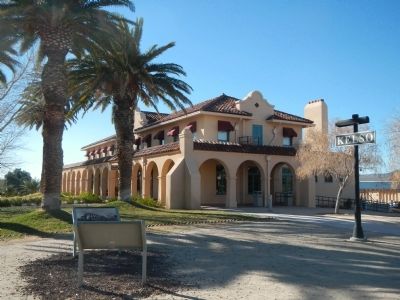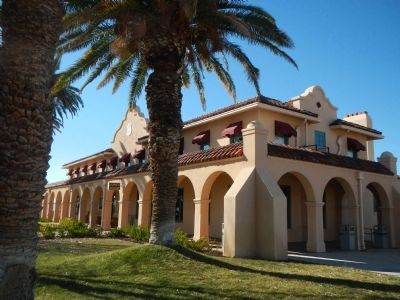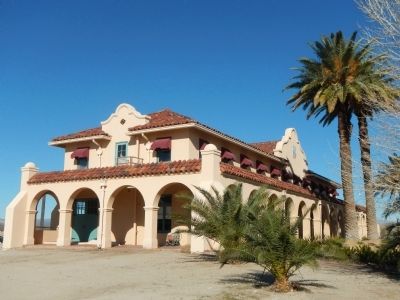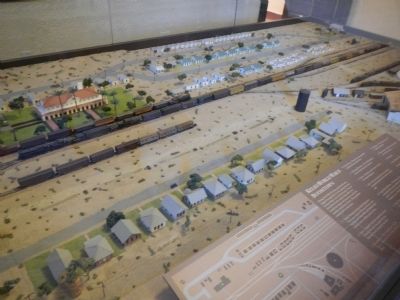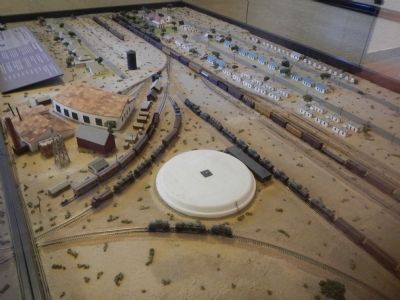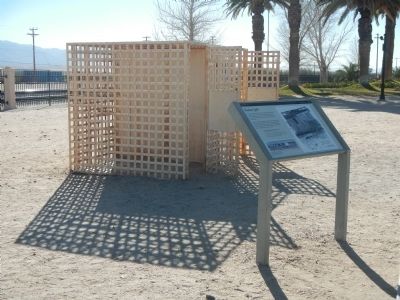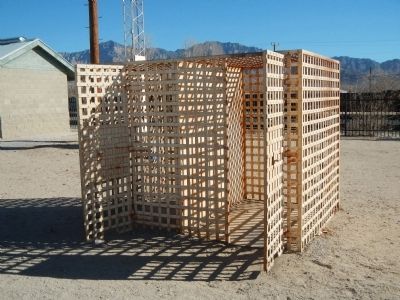Kelso in San Bernardino County, California — The American West (Pacific Coastal)
Kelso Depot
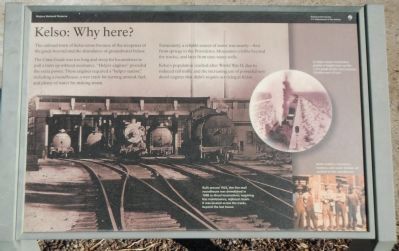
Photographed By Barry Swackhamer, January 21, 2015
1. Kelso: Why here? panel
Captions: (left) Built around 1923, this five-stall roundhouse was demolished in 1948 as diesel locomotives, requiring less maintenance, replaced steam. It was located across the tracks, beyond the last house.; (circle) A helper steam locomotive pushes a freight train up the 2.2% grade to the Cima Summit, 19 miles east of here.; (bottom right) Boiler-makers, mechanics, hostlers, and water tenders all worked at the roundhouse.
The Cima Grade was too long and steep for locomotives to pull a train up without assistance. “Helper engines” provided the extra power. These engines required a “helper station,” including a roundhouse, a wye track for turning around, fuel, and plenty of water for making steam.
Fortunately, a reliable source of water was nearby - first from springs in the Providence Mountains (visible beyond the tracks), and later from nine water wells.
Kelso’s population crashed after World War II, due to reduced rail traffic and the increased use of powerful new diesel engines that didn’t require servicing in Kelso.
As railroad technology improved and further personnel were needed, the Depot became obsolete. It was closed in 1985, and Union Pacific planned to raze the building. Concerned citizens intervened and the building was saved. It was renovated and reopened as a National Park Service Visitor Center in October, 2005.
To accommodate workers and their families, both Union Pacific Railroad and Kaiser Steel set up temporary housing at Kelso.
The jail was removed from Kelso in 1985, the same year that Union Pacific closed the Kelso Depot. It ended up in the backyard of Ron and Kay Mahoney in Barstow, California. Two decades later, Kay Mahoney donated it to the National Park Service when Kelso Depot reopened as a visitor center in 2005.
Richard Klepper grew up in Kelso, and remembers when the jail first arrived around
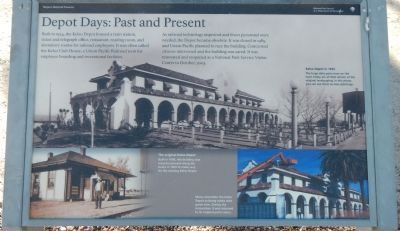
Photographed By Barry Swackhamer, January 21, 2015
2. Depot Days: Past and Present panel
Captions: (top) Kelso Depot in 1924. The huge date palm trees on the lawn are all that remain of the original landscaping. In this photo you can see them as new plantings.; (bottom left) The original Kelso Depot. Built in 1905, this building was moved eastward along the tracks in 1923 to make way for the existing Kelso Depot.; (bottom right) Many remember the Kelso Depot as being white with green trim. During the renovation, it was returned to its original paint colors.
Erected by National Park Service, U.S. Department of the Interior.
Topics. This historical marker is listed in these topic lists: Roads & Vehicles • War, World II. A significant historical month for this entry is October 2005.
Location. 35° 0.731′ N, 115° 39.172′ W. Marker is in Kelso, California, in San Bernardino County. Marker is on Kelso Cima Road near Kelbaker Road, on the right when traveling east. Touch for map. Marker is at or near this postal address: 90942 Kelso Cima Road, Baker CA 92309, United States of America. Touch for directions.
Other nearby markers. At least 2 other markers are within 14 miles of this marker, measured as the crow flies. Kelso Jail (within shouting distance of this marker); The Mojave Road (approx. 14 miles away).
More about this marker. The Kelso Depot is located in the Mojave National Preserve.
Also see . . . Kelso Depot - National Park Service. Originally, the restaurant and telegraph office each had three shifts, operating around the clock. This continued through the boom years of the 1940s, when Kaiser’s Vulcan mine caused Kelso’s population to grow to nearly 2,000.
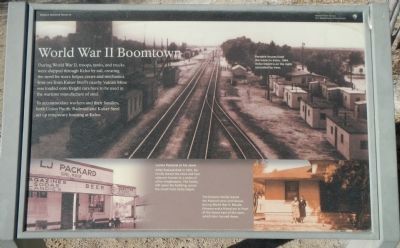
Photographed By Barry Swackhamer, January 21, 2015
3. World War II Boomtown panel
Captions: (top) Portable houses lined the tracks in Kelso, 1944. Kelso Depot is on the right, concealed by trees.; (bottom left) Lester Packard at his store. After Packard died in 1941, his family leased the store and two adjacent houses to a series of other shopkeepers. The family still owns the building, across the street from Kelso Depot.; (bottom right) The Grissom family leased the Packard store and houses during World War II. Maude Grissom and a friend are in front of the house east of the store, which later burned down.
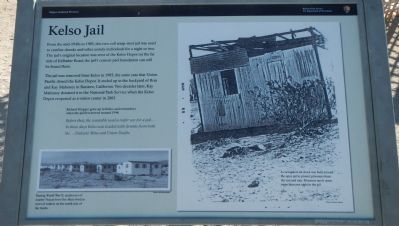
Photographed By Barry Swackhamer, January 21, 2015
4. Kelso Jail panel
Captions: (bottom left) During World War , employees of nearby Vulcan Iron Ore Mine lived in rows of trailers on the north side of the tracks.; (right) A corrugated-tin shack was built around the open jail to protect prisoners for the sun and rain. Prisoners rarely spent mort than one night in the jail.
Credits. This page was last revised on June 16, 2016. It was originally submitted on January 31, 2015, by Barry Swackhamer of Brentwood, California. This page has been viewed 533 times since then and 27 times this year. Photos: 1, 2, 3, 4, 5, 6, 7, 8, 9, 10, 11. submitted on January 31, 2015, by Barry Swackhamer of Brentwood, California. • Syd Whittle was the editor who published this page.
